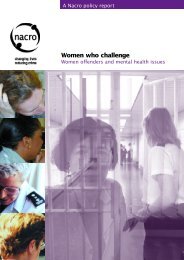Let's get it right: race and justice 2000 - Nacro
Let's get it right: race and justice 2000 - Nacro
Let's get it right: race and justice 2000 - Nacro
- No tags were found...
Create successful ePaper yourself
Turn your PDF publications into a flip-book with our unique Google optimized e-Paper software.
RACE AND JUSTICE <strong>2000</strong>CHAPTER 8 VICTIMS OF CRIMEThe previous ACPO defin<strong>it</strong>ion had been:‘Any incident in which <strong>it</strong> appears to the reportingofficer or investigating officer that the complaintinvolves an element of racial motivation or anyincident which includes an allegation of racialmotivation made by any person.’This was widely used by police forces but did not appearto be clearly understood by all police officers. Theperceived need to prove motivation may be one of thedifficulties that officers had w<strong>it</strong>h <strong>it</strong>, according to HomeOffice research; in add<strong>it</strong>ion <strong>it</strong> suggests that some officersfelt the ACPO defin<strong>it</strong>ion lim<strong>it</strong>ed their own discretion <strong>and</strong>made them record a crime solely on the basis of thevictim’s statement.Officers on the street may dispute the new defin<strong>it</strong>ion asthey did the earlier one. They may feel <strong>it</strong> challenges theirabil<strong>it</strong>y to make judgements about the credibil<strong>it</strong>y ofw<strong>it</strong>nesses or reliabil<strong>it</strong>y of evidence. But w<strong>it</strong>hout the in<strong>it</strong>ialrecording of an incident as racist, the subsequentinvestigative <strong>and</strong> prosecuting processes cannot betriggered; the in<strong>it</strong>ial recording is v<strong>it</strong>al.It is essential that the purpose of the defin<strong>it</strong>ion isexplained <strong>and</strong> training given to officers so that they areprepared to put <strong>it</strong> into practice. ACPO will be issuing arevised good practice guide on dealing w<strong>it</strong>h racistincidents in 1999.Rate of attr<strong>it</strong>ionThere is a large gap between the estimated number ofracially motivated offences (both BCS <strong>and</strong> PSI figures),the numbers that are reported to the police, the numbersthat are then actually recorded by the police, <strong>and</strong> thenumber subsequently prosecuted. Racially-motivatedincidents are more likely to be cleared up than nonracially-motivatedincidents, but less likely to result in acharge or a caution; 39% of racist incidents in theMaynard <strong>and</strong> Read research resulted in a charge,compared to 58% for non-racially motivated offences.Some of this variation is due to the use of informal meansof disposal which are not included in the non-raciallymotivated offences figures. But, the authors note:‘Clearly there is a need to address the issue of thisrate of attr<strong>it</strong>ion.’CPS racial incident mon<strong>it</strong>oringschemeThe CPS racial incident mon<strong>it</strong>oring scheme, establishedin 1995, was an important development in the 1990s. Itsaim is:‘To produce accurate information on the numberof racial incident prosecutions <strong>and</strong> their outcomes.To evaluate the information <strong>and</strong> take allappropriate steps to ensure the effectiveprosecution of all racial incidents.’Two annual reports have been published on the findings.In 1997/98, 1,506 cases were mon<strong>it</strong>ored, an increase of161 over the previous year. As in 1996/97, the policeidentified only 37% of these cases as racially motivated,while the CPS identified the remaining 63%. Newadministrative procedures have now been agreed betweenpolice forces <strong>and</strong> the CPS to try to improve the rate ofpolice identification.Early indications from the 1998/99 mon<strong>it</strong>oring are thatpolice performance in identifying racial incident cases hasimproved to the extent that they identified slightly overhalf of the cases subm<strong>it</strong>ted to the CPS for prosecution asracial incidents.Prosecutions were dropped in 12% of cases. 1,324 caseswere prosecuted, w<strong>it</strong>h a conviction rate of 83%. In 1,151cases there was admissible evidence of racial motivation,which was brought to the court’s attention in 85% of thecases. However courts indicated that they had increasedthe sentence because of racial motivation in only 22% ofthese cases.The CPS mon<strong>it</strong>oring scheme is a very pos<strong>it</strong>ive movetowards ensuring an effective criminal <strong>justice</strong> response toracially motivated offences. It has shed new light on whathappens towards the end of the process, to complementwhat is known about the beginning – the base of thetriangle of unreported <strong>and</strong> unrecorded crime. The schemewill be revised to take account of the changes introducedby the Crime <strong>and</strong> Disorder Act 1998, to ensure <strong>it</strong>continues to meet <strong>it</strong>s objectives.Crime <strong>and</strong> Disorder Act 1998This important new legislation has the potential to dealw<strong>it</strong>h a greater number of cases than before, including thetype of ‘low level’ harassment described earlier as well as51

















